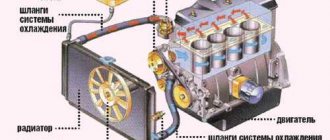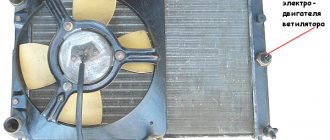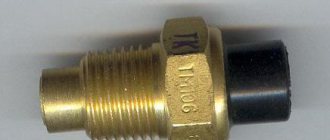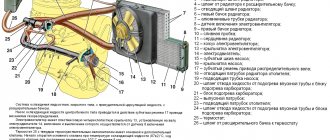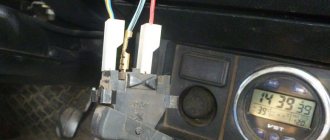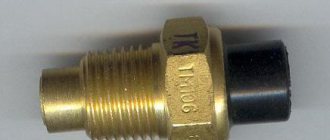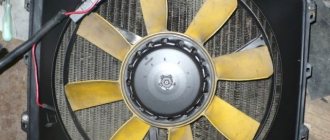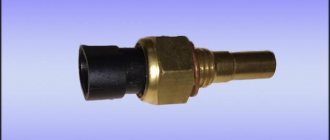A common problem with a car's cooling system is a failed fan. It stops functioning. As a result, the running motor overheats, which leads to serious problems. In most cases, the device is damaged because the fan on-off sensor (FVS) is broken. To replace it, you need to know what it is, where it is located and how it works.
Basic functions of the radiator fan sensor
The radiator fan is one of the main devices that protects the engine from overheating not only on hot days, but also during heavy driving in traffic jams or prolonged idling.
- Its operation is evidenced by a characteristic noise emanating from under the hood of the car.
- Most often, it turns on when the engine is warm, when the radiator to remove accumulated heat is not working.
When the need arises, the fan starts and cools the thermally stressed engine for a few minutes, and when the temperature stabilizes at the desired level, the fan turns off. The radiator fan sensor is responsible for the effective operation of this system.
The thermal switch, that is, the fan sensor, performs one main and very important task: turn on the drive fan at the right time. This is usually the time when the engine coolant temperature exceeds the acceptable level.
The radiator fan sensor is responsible for preventing the fan from running continuously when it is not necessary, such as in winter. When the coolant reaches a critical temperature level, the sensor initiates the closure of the electrical circuit and the fan motor turns on.
Replacement with draining antifreeze
If you discover that the device is not functioning correctly or is completely inoperable, you need to replace it with a new one. To perform dismantling, you must follow the instructions:
- If the engine is hot, it must be allowed to cool;
- De-energize the vehicle ground by disconnecting the negative terminal;
- Remove the expansion tank cap;
- Remove ;
- To prevent contamination, it is necessary to place a container under the drain hole;
- Drain the antifreeze from the . There is no need to drain antifreeze from the cylinder block. To unscrew the drain plug, just a hand is enough, so no tools are needed;
- When the liquid stops flowing out, you should return the plug to its place to avoid its loss;
- Remove the terminal with wires;
- Use a wrench to carefully unscrew the sensor.
Faulty radiator fan sensor
The radiator fan sensor has a tendency to cause various types of breakdowns. Their effect can be, among other things, continuous, regardless of the coolant temperature, fan operation or complete refusal to switch on the device, despite a sharp increase in the temperature of the drive unit.
In such a situation, there is nothing left but to replace the thermal switch with a new one.
- The radiator fan itself is also susceptible to malfunctions, where, for example, mechanical damage to the blades or wear to the fan shaft bearings can occur.
- Also, the viscous coupling often fails, which is usually evidenced by a rather loud noise when the fan operates or rotates at a speed equal to the speed of the drive unit.
VAZ 2114, VAZ 2115
On these cars, GM 2112-3851010-01 can be used as a DTOZH. The location of the device is between the cylinder head and the thermostat.
To check, it is recommended to dismantle the element (open-end wrench size 19). To do this, you need to wait until the engine cools down, reset the negative voltage on the battery and drain the antifreeze.
After this, you need to dismantle the device and check it by heating the liquid, a thermometer and a multimeter.
The following parameters must be present.
Table 2.
| Temperature, 0C | Resistance, Ohm | Voltage, V |
| +30 | 1350-1880 | 8 |
| +50 | 585-820 | 7,6 |
| +70 | 280-390 | 6,85 |
| +90 | 155-196 | 5,6 |
| +110 | 87-109 | 4,7 |
If there is a discrepancy in the readings, the device must be replaced.
How to check a radiator fan
Set the car heater to cold and start the car. The engine should warm up to normal operating temperature.
Let the power unit run for about five minutes, watching the temperature gauge (do not allow the car to overheat). The radiator fan sensor should automatically turn on the cooling and the temperature gauge should return to normal.
If the fan does not turn on and the temperature is constantly rising, there is likely a breakdown and you should seek professional help as soon as possible.
Gazelle (engines ZMZ 406, 405, 409)
Installation location - on the power unit in the area of the thermostat or on the body of the latter.
To remove it, it is necessary to partially drain the coolant from the engine, disconnect the spring clamp of the harness block and discard the block from the sensor.
Next, using a key set to “19” you need to loosen the broach and unscrew the device.
When choosing a device, you need to focus on the engine and ECU.
406 engine and ECU Mikas 7.1, 5.4, SOATE, VS5.6
In such cases, a DTOZH is used, operating at a voltage of 5 to 12 Volts through a resistance of 9.1 kOhm.
Several types of devices are suitable for replacement: Kaluga 19.3828, Luzar LS 0306, Rikor 40.5226 or Autotrade 42.3828.
When checking, you will also need water with a boiler and variable temperature, as well as a multimeter.
To work, you need to assemble a circuit and apply 1 to 1.5 mA to it. In this case, it is necessary to measure not resistance, but voltage.
When checking, the following parameters must be present:
- -60 0С - 2.13 V;
- -40 0C - 2.33 V;
- -20 0C - 2.53 V;
- 0 0C - 2.73 V;
- +40 0С - 3.13 V;
- +80 0С - 3.53 V;
- 105 0C - 3.83 V;
- 125 0C - 3.98 V.
When the engine is running, the voltage will be 5 V.
Engine 405, 409, UMZ 4216E3, 4213 control unit Mikas 11 / 10.3, VS8, SOATE
DTOZH with catalog numbers 234.3828, 40.5215 or 421.3828 are used here.
Unlike the method discussed above, here it is necessary to measure resistance.
In this case, the dependence should be as follows:
- 128 0C - 80.8 Ohm;
- 100 0С - 177 Ohm;
- 80 0С - 332 Ohm;
- 60 0С - 667 Ohm;
- 40 0С - 1459 Ohm;
- 20 0С - 3520 Ohm;
- 0 0С - 9420 Ohm;
- -20 0С - 28680 Ohm;
- -40 0С - 100707 Ohm.
In case of significant deviations from these parameters, the device must be replaced.
When should the fan turn on?
The radiator fan only operates when the engine coolant temperature reaches certain degrees. This fluid is not always found in the constantly operating part.
The fan should only run for a certain amount of time when the car is hot and then stop. If the device malfunctions, car owners may experience continuous operation. Let's take a quick look at the causes of the problem.
Kalina
The official version of the DTOZH for the VAZ 2112 is 2112-3851010. But you can use analogues, for example, ERA (33026), Luzar (LS 0112), Fenox (TSN 2211207).
The location of the sensor on a car with an 8- and 16-valve engine is near the thermostat. In this case, the device is slightly closed by the filter housing.
In this case, on the Lada Kalina 1 you will have to remove the air filter to access the temperature meter.
To unscrew, use a 19 key. There is no need to drain the antifreeze.
Check, as in the previous case, after removing the device with the key to “19”.
For temperature and resistance readings, see Table 3.
Checking the presence of operating voltage is carried out with a multimeter with the ignition on without removing the sensor between the block terminal “B” and ground (there are two terminals on the blocks “A” and “B”), standard readings are within 4.8-5.2 V.
Radiator fan runs constantly
If the radiator fan is running all the time, this could be due to several reasons.
Here is a basic list of these reasons:
- The radiator fan switch may be faulty;
- Possible temperature sensor malfunction;
- Problems with the electrical equipment of the chassis;
- Electricity can directly reach the fan motor;
- The engine control unit may fail;
It can also be caused by different parts and systems depending on the make and model of the vehicle.
If the radiator fan is running constantly, the solution has not been made and problems may arise if it continues to be used in this way;
- The fan may completely fail due to continuous operation;
- The fan does not work, which can cause overheating problems;
- Possible problems may lead to battery discharge due to the fan starting when the car's ignition is turned off;
- This can cause different problems depending on the make and model of the car.
Features of checking for VAZ 2110
The “tens” configuration includes two types of engines – 8 and 16 valves. But the features of the DTOZH, location and replacement are identical.
On these VAZ 2110 you can use the Lusar LS 0101 temperature sensor. The car has two coolant temperature meters installed, one near the thermostat and it interacts with the computer, the second on the radiator and transmits data to the instrument panel.
The procedure for checking is the same; resistances at different temperatures are shown in Table 1.
Radiator fan operating modes
When does the radiator fan turn on? The radiator fan has two different operating modes. While the first stage works slowly and continuously, the second stage works very quickly and for a short time.
The status of this level may differ depending on the car brand, but in general the levels are as follows.
- The first mode is activated in the temperature range of 60-70 degrees. The second mode begins to operate in the range of 80-95 degrees, quickly lowering the temperature of the engine coolant at a very high speed. The fan then returns to its normal first cycle,
- The radiator fan running at this high speed should change depending on the engine temperature and stop running within a range of 40 seconds to 2 hours.
- If you have a fan that runs longer than this or without stopping, or if it runs even at very low engine temperatures, this indicates serious problems.
Considering the above results, radiator fan failure due to continuous operation may be too risky and the results may be very costly. Therefore, the problem must be solved without forgetting about it.
If the radiator fan is running all the time, you can ask us all your questions, such as what is the reason and how to solve it. To ask a question, you can submit your questions by mentioning your vehicle make and model in the comments section below. We receive answers to questions asked daily.
Types of devices, what they are used for
The sensor is a simple device. It consists of a pair of terminals and a bimetallic (brass-invar (iron-nickel alloy)) plate.
- For the cooler to work, an electric current is supplied to the device.
- It's warming up.
- Because of this, the plate expands.
- She closes the contacts.
- Next, voltage is supplied to the excitation winding in the fan motor.
- The cooler blades begin to spin.
In the newest cars with injection engines, the electronic unit that controls the engine is responsible for turning on the sensor. The functions of the block are the collection and processing of data from all indicators mounted in the machine. Based on the collected information, the electronics decide whether the fan should turn on. In older cars with carburetor engines, electromechanical sensors are installed that have a response temperature scale.
Depending on what type of device is installed, the cooler's turn-on time changes. You can find out at what temperature conditions the device operates by looking at the markings. They are located on the device body.
